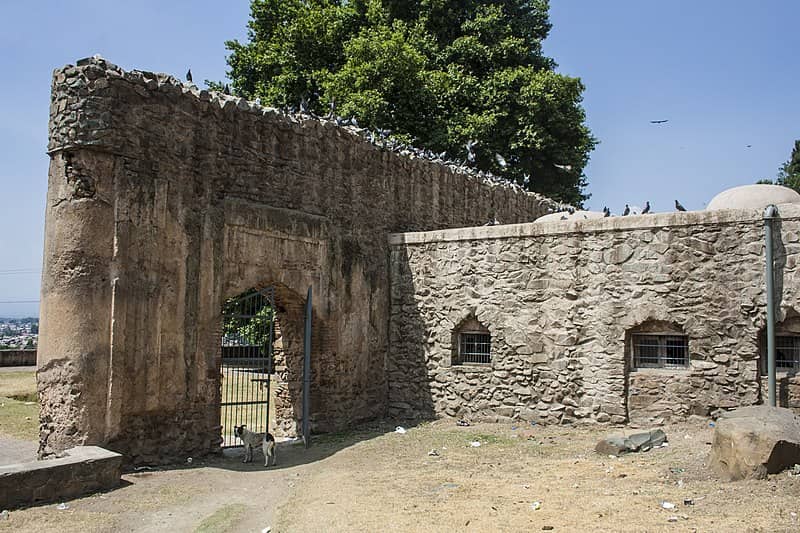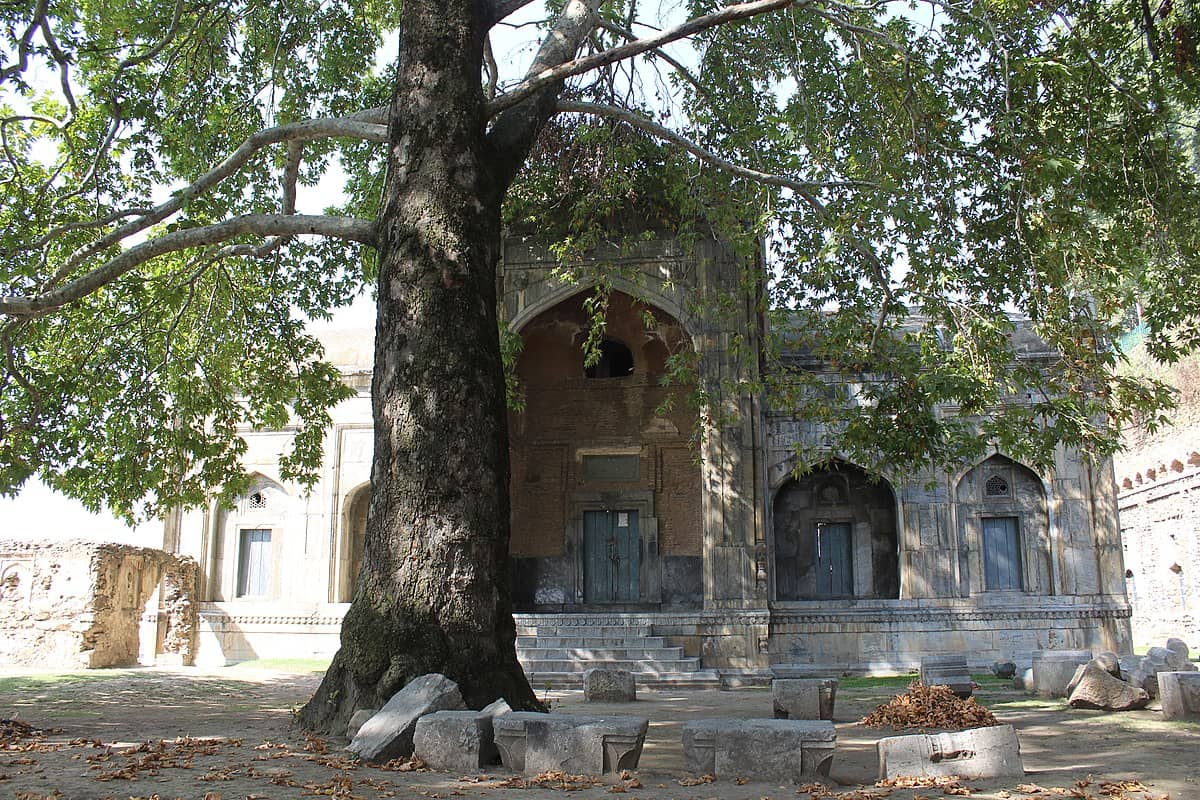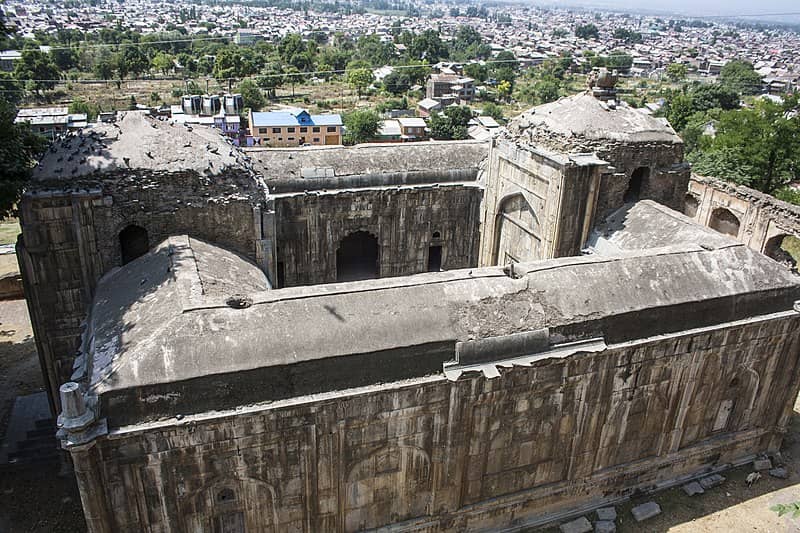Of Mughals, Mentorship, Mysticism — When Love Bloomed As Lotus in Kashmir

Umar Hayat Hussain has worked with Kashmir Life, Kashmir Impulse,…
The structure perched on the flagged hill has become a syncretic symbol in the valley of saints known for mystical love.
On an unclouded winter day in Kashmir, Shaheen Bhat entered Old City’s Kathi Darwaza whispering darood. Walking towards the Makhdhoom Sahab shrine in a meditative trance, he saw a swarm of faithful following his footsteps. The moment he reached and scaled the flight of stairs, he stopped to give alms to some pleading paupers sitting around. He shortly resumed his ascent with a submissive body language.
Paying obeisance at the elevated sanctum every Wednesday, Shaheen rests near a courtyard dotted with Chinars and wonders about the padlocked mosque’s lotus look and the ‘transcendental love’ that it stands for.
There’s a legend about this secluded Islamic structure with syncretic shades. It’s believed to be interconnected with the hill shrine via a secret underground passage but the path is said to be invisible.
“Only the arch is seen on the ground level,” Shaheen, taking a breather, said.
“This sanctum might be lost in the shade of the massively devoted Makhdoom sahib shrine, but its unique identity as a symbol of spiritual love has always fascinated me as a researcher.”
Support Our Journalism
You are reading this because you value quality and serious journalism.
But, serious journalism needs serious support. We need readers like you to support us and pay for making quality and independent journalism more vibrant.

The sacred structure is one of the Mughal marvels in Kashmir and goes by the name of Masjid Mullah Akhoon Shah. Its construction began in 1649 and by 1658 AD, it became one of the noted structures at Koh-e-Maran overlooking Shahr-e-Khaas.
To understand its history, I paid a quick visit to Kashmir’s noted chronicler, Zareef A. Zareef, living at a stone’s throw from the shrine.
In his sunny courtyard, the poet was living up to his amusing self and sparking the conversation with his signature satirical style.
“This mosque locally called as Mala Shah Masjid is the only type in Kashmir with stone lotus erected over the podium,” Zareef said with his quintessential diction.
“It was built by Mughal scion Dara Shikoh, who was the son of Emperor Shah Jahan to honour his mentor, Mullah Akhoon Shah Badakashi.”
But Afshan Bokhari, an Assistant Professor of Art History at Suffolk University, Boston USA, says that it was Jahan Ara Begum, Shah Jahan’s daughter, who built the mosque for her mentor, Mullah Akhoon.
“The mosque is Ara’s commission, as the Shah Jahan Nama and the British gazetteer indicate that Ara was the patron of the mosque,” said Afshan, who has worked extensively on Mughal court documents from the 16th to 18th century.
“Shikoh constructed retreat for his spiritual guide Mullah Akhoon on the Zabarvan hills commonly called Pari Mahal.”

After paying obeisance at the hill shrine, Shaheen sat at the vantage point offering a bird’s eye view of the mosque’s geometrical model. The aerial view makes it a captivating piece of rundown heritage.
Shaheen quoted Kashmiri Encyclopedia to claim that the mosque has stones and jewels engulfed in its walls.

“Shikoh was very much fond of Astrology and Palmistry and that’s the reason he built this structure first,” Shaheen said.
“He later added mosque, Hamam and prayer chambers so that his mentor could stay in harsh winters here in Kashmir.”
But Shikoh’s peer, Afshan said, had to face the Mughal court for his controversial poetry on Tawhid.
“His contested couplets made religious scholars sign and seek his execution,” Afshan said.
“But Shikoh and Ara requested their emperor father to review the disputed verses before sealing their mentor’s fate.”
Emperor Shah Jahan eventually made the decree invalid, and paved the way to a twenty-year-long mentorship.

In his chirpy courtyard, Zareef talked about the recent restoration work by the Archeological Survey of India (ASI) and how it revealed a 380-year-old uncut Quranic text in the Mullah Akhoon Mosque.
“A closer inspection reveals that Quranic verses from Aayatal Kursi running across the whole arch and Kalmia Shahada written in great calligraphic style could be an area of research,” ASI said in its findings.
The couplets on the walls of the mosque, Afshan said, decipher the purpose of establishing this mosque.
“They’re very similar to her (Ara) own poetry in her Sufi treatise — Risala-i-Sahibiyah,” the researcher revealed. “A similar panegyric Persian praise has been used at Agra Mosque that Ara built.”
At the twilight, when the old city gets roofed under the invading gloom, Shaheen descended the gruelling stairway.
He rested near the lotus mosque and wondered about the inscription on the threshold engaging in a more secular invitation: ‘Oh the opener of the gates has come. Whoever enters it will be safe.’
“That the Islamic structure has syncretic shades speaks volumes about the so-called rulers demonized as ‘invaders’ today,” Shaheen scoffing at the current debate concluded.
“This lotus mosque should teach them a lesson or two on tolerance.”
Mountain Ink is now on Telegram. Subscribe here.
Become Our Ally
To help us strengthen the tradition of quality reading and writing, we need allies like YOU. Subscribe to us.
Umar Hayat Hussain has worked with Kashmir Life, Kashmir Impulse, Kashmir Times, Kashmir Reader, among other publications. He is currently an editorial intern at the Mountain Ink.













